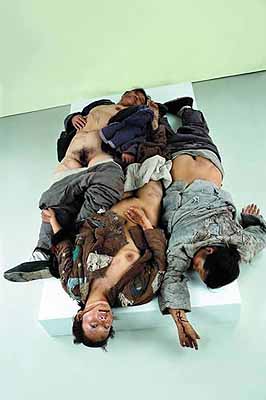Born at 1969, Liu Zheng was together with Rong Rong, editor of "New Photo".
This Chinese photographer shows in his works a will to create photo narratives.

One of his most well known works - The Chinese, depicts a sort of documentary style photography.
Some critics found it close to assumed documentary photographers, like Diane Arbus or even Robert Frank (within others).
It's clear in this work that Zheng wants to present the contrasts undergoing on Chinese society - the lower class (like the coal miners shown in the photo, at left) and the new uprising society of business man.
Though, despite the black and white of this work, there's a gray area - the Chinese people which live in he boundaries of social acceptance, namely street performers, travesties, strippers, homeless children, Buddhist monks and mental disabled.
The photos belonging on this series (and the result of several years of work and travel at China Mainland) have a common ground which unites all the characters - Death.
The social differences highlighted on the photos of the living loose all the meaning in the face of a deceased individual - another unifying contrast (presenting groups of living individuals against the death of one).

Soon, Liu Zheng changed his style from the Realistic approach. In a way he distances himself from The Chinese producing a more choreographed and surrealistic body of work.
Zheng acts now as a director for his models in unique scenarios filled with violence, death and nudity.
This attitude also shows an attempt to escape from the accepted photographic style available during Post Cultural Revolution - enhancing the distance from his previous work and at the same time a sort of preparation for next turn on his work.
That turn can be found in his recent work, like four instance the Four Beauties (shown below).

In this series of photographs there's an evocation of past memories. Episodes of Chinese History rewritten by his lens, and where's patent the drama and again violence and sexual desire in the built of China History.

These could also be the words used to describe
another of his works - Revolution.
Here, he reconciles again with his earlier work, but now contrasting the cruel rawness of Reality with the choreographed explicit violence of his new photos.
It's interesting the pursue of women as the main victims of Revolutions wars or meaningless violence.
This Chinese photographer shows in his works a will to create photo narratives.

One of his most well known works - The Chinese, depicts a sort of documentary style photography.
Some critics found it close to assumed documentary photographers, like Diane Arbus or even Robert Frank (within others).
It's clear in this work that Zheng wants to present the contrasts undergoing on Chinese society - the lower class (like the coal miners shown in the photo, at left) and the new uprising society of business man.
Though, despite the black and white of this work, there's a gray area - the Chinese people which live in he boundaries of social acceptance, namely street performers, travesties, strippers, homeless children, Buddhist monks and mental disabled.
The photos belonging on this series (and the result of several years of work and travel at China Mainland) have a common ground which unites all the characters - Death.
The social differences highlighted on the photos of the living loose all the meaning in the face of a deceased individual - another unifying contrast (presenting groups of living individuals against the death of one).

Soon, Liu Zheng changed his style from the Realistic approach. In a way he distances himself from The Chinese producing a more choreographed and surrealistic body of work.
Zheng acts now as a director for his models in unique scenarios filled with violence, death and nudity.
This attitude also shows an attempt to escape from the accepted photographic style available during Post Cultural Revolution - enhancing the distance from his previous work and at the same time a sort of preparation for next turn on his work.
That turn can be found in his recent work, like four instance the Four Beauties (shown below).

In this series of photographs there's an evocation of past memories. Episodes of Chinese History rewritten by his lens, and where's patent the drama and again violence and sexual desire in the built of China History.

These could also be the words used to describe
another of his works - Revolution.
Here, he reconciles again with his earlier work, but now contrasting the cruel rawness of Reality with the choreographed explicit violence of his new photos.
It's interesting the pursue of women as the main victims of Revolutions wars or meaningless violence.

Currently, his work seems to be start to be also distant from Chinese reality.
Survivors is he name of a new series. Here the violence appears more crude, but without the epic scenery of his previous works.
The photos are simpler, yet intense.
Here the face of Global Death is portrayed in evoking a breakthrough of China as a Global country - the world united by Death (as if it was a bigger scale than the one used from The Chinese).
This openness to the outside could be analyzed as a "breach" in the usual Chinese secrecy, but at a same it's clear in this work the inevitable natural tendency for the Chinese people to become more and more global citizens.
Links: Liu Zheng



